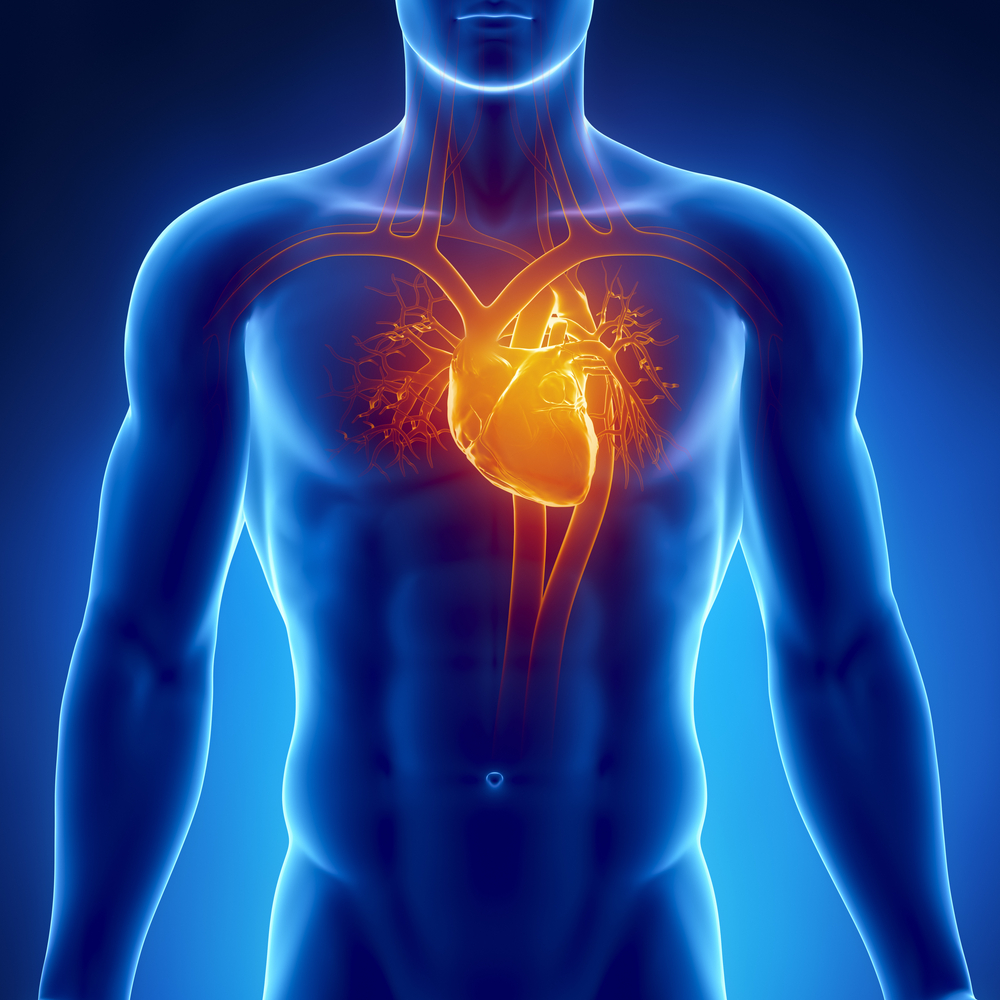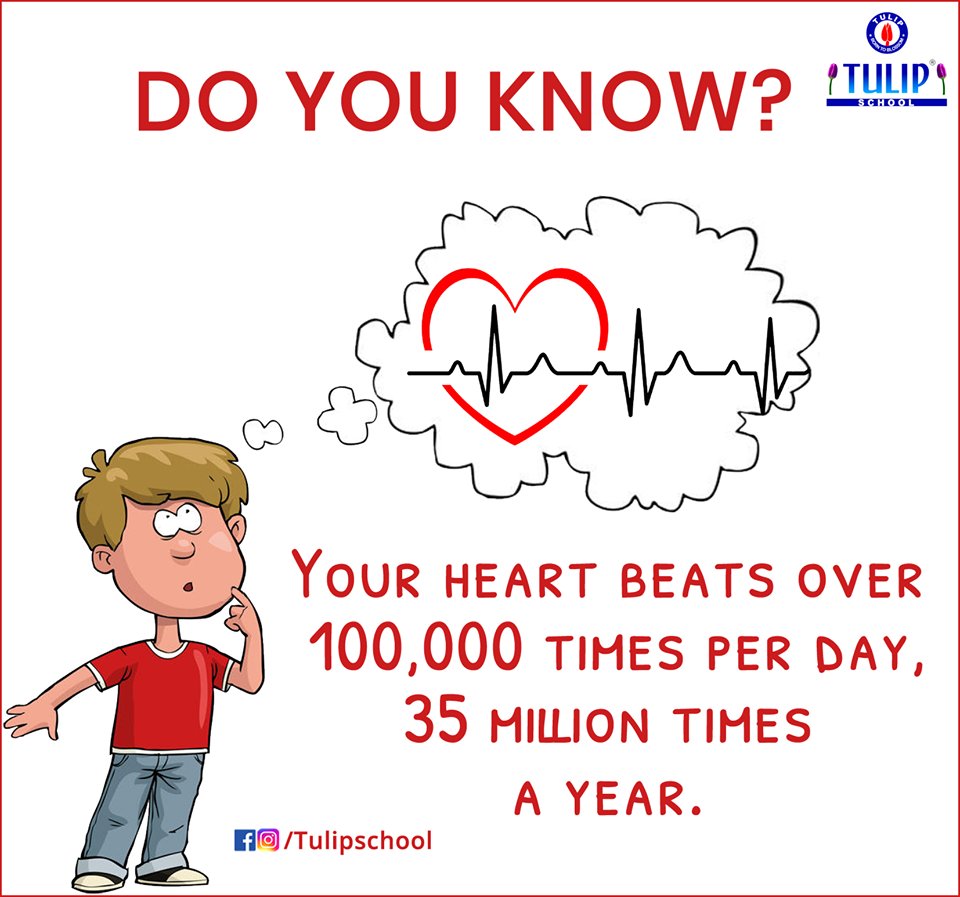
1. Your heart can weigh between 7 and 15 ounces.
A man’s heart weighs, on average, around 10 ounces and a woman’s heart weighs around 8 ounces.
2. Newborn babies have the fastest heart beats.

A newborn’s heart rate is around 70 to 190 beats per minute. The average adult should have a resting heart rate between 60 and 100 beats per minute. If your resting heart rate is higher or increases over several years, it could be a sign of current or impending heart problems. Athletes, who regularly train, will have a very slow resting heart rate around 40 to 60 beats per minute. Women also have faster heart rates, on average, than men because their hearts are smaller in size and need to beat more to pump the same amount of blood.
3. Your heart is located in the middle of your chest.

It’s found behind your breastbone, but it’s tilted to the left, which makes it easier to feel on that side of your chest.
4. Your heart beats around 100,000 times a day.

The sound you hear when it beats is actually the noise of the heart valves opening and closing.
5. Your heart pumps 2,000 gallons of blood a day.

That blood travels about 12,000 miles through your body each day, which is four times the size of the U.S. from coast to coast. During your lifetime, you pump about one million barrels of blood.
6. Heart attacks happen most often on Monday mornings.
Stress hormones are higher in the mornings than at any other point during the day, and Mondays in particular seem to cause people more stress than other days of the week. A rise in blood pressure, plus an increase in heart rate and stress hormones can break pockets of plaque and cause a blockage to the heart.
7. There are 60,000 miles of blood vessels in your body.

If one of the vessels is damaged, it makes your heart have to work harder to pump your blood.
8. No one knows why the heart is associated with love.
Different civilizations and historical time periods had different meanings for the heart. The belief that the heart controlled all thought and emotion was the general assumption in ancient civilizations. They also believed that the brain was completely useless. Over time, the idea that love came from the heart stuck in popular culture.
9. Men and women have different heart attack symptoms.
The symptoms of a woman having a heart attack are much less prominent than a man. For women, heart attacks can feel like uncomfortable squeezing, pressure, fullness or pain in the center of the chest. It can also produce pain in one or both arms, the back, neck, jaw or stomach, shortness of breath, nausea and other symptoms. Men experience the typical heart attack symptoms of chest pain, discomfort and pressure. They, too, can experience pain in other areas, such as the arms, neck, back and jaw, as well as shortness of breath, sweating and discomfort that mimics heartburn.
10. Laughing is good for your heart.
Studies have shown that your blood vessels relax when you’re laughing, which sends 20% more blood through your body. Relaxed blood vessels mean your heart doesn’t have to work as hard.
11. The heart works twice as hard as the leg muscles of a sprinter.
It takes a lot of force to move your blood around your body, and that is why a strong, healthy heart is so important. The heart, which is a muscle, has twice the power of the leg muscles of someone sprinting.
12. Sneezing does not stop your heart.
Contrary to popular belief, sneezing does not stop your heart or make it “skip a beat.” It can, however, briefly change your heart’s rhythm. The only time your heart stops is during cardiac arrest.
13. Your aorta is as large as a garden hose.
The biggest artery in your body, the aorta, runs from your heart to your belly. It carries the most blood and is also the most common sight for problems like aneurysms.
14. A “broken heart” can feel like a heart attack.
Intense and sudden feelings of sadness can mimic the symptoms of a heart attack. Stress hormones are released into the body and can cause chest pain and shortness of breath. Luckily, with a little bit of rest, your heart will begin to feel normal.
15. Some capillaries are ten times smaller than a human hair.
They are so small that blood cells have to travel single-file through them. Oxygen and carbon dioxide are exchanged through the very thin walls of the capillaries.
16. Horses can mirror a human’s heart rate.
A study showed that a horse can mimic the heart rate of the person touching them. Along with dogs and cats, horses have been added to the list of animals that are emotionally responsive to humans, and they may one day be used to detect stress hormones in patients.
17. Your adult heart beats about 100,000 times each day.Do the math, and that’s at least one beat every second, or 60 to 100 times a minute, according to the American Heart Association. For people whose heart rate is closer to 60 beats per minute (bpm), that’s about 86,000 times a day. And it’s 144,000 times a day if your heart rate is closer to 100 bpm.
18. Age and fitness level affect your heart rate. Generally, as children grow or adults get fitter, the heart rate gets slower. See how it changes throughout the decades with this chart from the National Institutes of Health:
- Newborn (0 to 11 months): 70 to 160 bpm
- One to four years: 80 to 120 bpm
- Five to nine years: 75 to 110 bpm
- Children 10 years and up and adults (non-athletes): 60 to 100 bpm
- Adults (athletes): 40 to 60 bpm
19. Heart disease isn’t only the number one killer of men, it’s also the top killer for women. Your heart doesn’t care if you’re from Mars or Venus. “Heart disease is an equal opportunity buzz kill,” says James Beckerman, MD, director of the Center for Prevention and Wellness at the Providence Heart and Vascular Institute in Portland, Oregon, and author of Heart to Start (2015). More women die of heart disease than from most cancers combined, notes Dr. Beckerman.
According to the American Heart Association (AHA), more than one in three women is living with heart disease. Every minute in this country, one woman dies from heart disease, stroke, or another form of cardiovascular disease.
20. Want to know how big your heart is? Make a fist. Heart size depends on the size of the person as well as the condition of their heart. Generally speaking, a healthy heart is about the size of the person's fist.
That’s only a healthy heart, though. “Hearts can enlarge in response to certain conditions,” says Kathryn Boling, MD, a family medicine physician with Lutherville Personal Physicians in Lutherville, Maryland. For instance, congestive heart failure can cause the heart to enlarge, explains the American College of Cardiology.
21. Your heart rate drops while you sleep. At night, it’s common for heart rates to drop below 60 bpm. Some people even have rates in the 40s while sleeping. Why? “It’s because your metabolism slows and the parasympathetic nervous system, which slows your heart and relaxes you, is more active,” Boling says.
22. Heart attack symptoms are different in men and women. Although heart disease is an equal opportunity killer, symptoms of heart attack show up differently in men versus women. Whereas men often report crushing chest pain, sweating and nausea, women might instead experience shortness of breath, dizziness, lightheadedness or fainting, pain in the lower chest or upper abdomen,a nd upper back pressure, notes the AHA.
23. Your activity level is the greatest potential risk factor for heart disease. People with low fitness levels have double the risk of heart disease as their more active counterparts, Beckerman says. The AHA recommends logging at least 150 minutes of moderate-intensity exercise, or 75 minutes of vigorous activity, or a combination of the two, every week.
RELATED: 6 Heart-Health Benefits of Yoga
The good news is, “whether you’re on the treadmill, in the weight room, or in a yoga studio, your heart benefits from every type of activity,” he says. And 80 percent of heart disease is preventable with healthy lifestyle choices and management of risk factors, he adds. Other ways to lower heart disease risk include quitting smoking, controlling cholesterol, eating better, managing blood pressure, losing weight, and reducing blood sugar, according to the AHA.
24. Depression increases your risk for a heart attack, especially if you’re a woman. If you’re a woman under 55 with moderate or severe depression, listen up. This group of women are more than twice as likely to suffer a heart attack, die of heart disease, or require an artery-opening procedure, Boling says.
25. Excessive amounts of sitting have been linked to an increased risk of heart disease. You may have heard that sitting is the new smoking. Numerous studies show that spending most of the day on your duff has been linked to chronic health conditions, including heart disease.
“When we’re more active, even with smaller movements like when we stand or shift from side to side, our muscles turn on genes that create chemicals and proteins that not only help us process blood sugar and cholesterol more efficiently but also create a healthier atmosphere in the walls of our blood vessels,” Beckerman says. That then leads to a lower heart disease risk, which is why you should stand up and move around at least every hour for a few minutes.
26. Your heart is one giant pump. Every minute, your heart pumps about five quarts of blood through a system of blood vessels that's over 60,000 miles long, according to the Cleveland Clinic. That translates to about 2,000 gallons of blood every day.
No comments:
Post a Comment